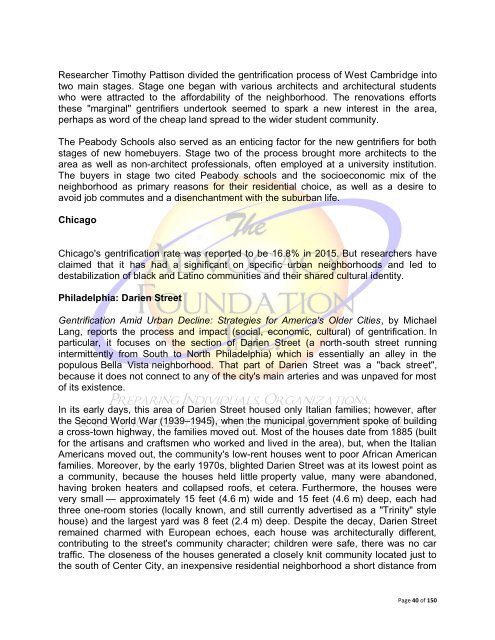Gentrification
Gentrification
Gentrification
You also want an ePaper? Increase the reach of your titles
YUMPU automatically turns print PDFs into web optimized ePapers that Google loves.
Researcher Timothy Pattison divided the gentrification process of West Cambridge into<br />
two main stages. Stage one began with various architects and architectural students<br />
who were attracted to the affordability of the neighborhood. The renovations efforts<br />
these "marginal" gentrifiers undertook seemed to spark a new interest in the area,<br />
perhaps as word of the cheap land spread to the wider student community.<br />
The Peabody Schools also served as an enticing factor for the new gentrifiers for both<br />
stages of new homebuyers. Stage two of the process brought more architects to the<br />
area as well as non-architect professionals, often employed at a university institution.<br />
The buyers in stage two cited Peabody schools and the socioeconomic mix of the<br />
neighborhood as primary reasons for their residential choice, as well as a desire to<br />
avoid job commutes and a disenchantment with the suburban life.<br />
Chicago<br />
Chicago's gentrification rate was reported to be 16.8% in 2015. But researchers have<br />
claimed that it has had a significant on specific urban neighborhoods and led to<br />
destabilization of black and Latino communities and their shared cultural identity.<br />
Philadelphia: Darien Street<br />
<strong>Gentrification</strong> Amid Urban Decline: Strategies for America's Older Cities, by Michael<br />
Lang, reports the process and impact (social, economic, cultural) of gentrification. In<br />
particular, it focuses on the section of Darien Street (a north-south street running<br />
intermittently from South to North Philadelphia) which is essentially an alley in the<br />
populous Bella Vista neighborhood. That part of Darien Street was a "back street",<br />
because it does not connect to any of the city's main arteries and was unpaved for most<br />
of its existence.<br />
In its early days, this area of Darien Street housed only Italian families; however, after<br />
the Second World War (1939–1945), when the municipal government spoke of building<br />
a cross-town highway, the families moved out. Most of the houses date from 1885 (built<br />
for the artisans and craftsmen who worked and lived in the area), but, when the Italian<br />
Americans moved out, the community's low-rent houses went to poor African American<br />
families. Moreover, by the early 1970s, blighted Darien Street was at its lowest point as<br />
a community, because the houses held little property value, many were abandoned,<br />
having broken heaters and collapsed roofs, et cetera. Furthermore, the houses were<br />
very small — approximately 15 feet (4.6 m) wide and 15 feet (4.6 m) deep, each had<br />
three one-room stories (locally known, and still currently advertised as a "Trinity" style<br />
house) and the largest yard was 8 feet (2.4 m) deep. Despite the decay, Darien Street<br />
remained charmed with European echoes, each house was architecturally different,<br />
contributing to the street's community character; children were safe, there was no car<br />
traffic. The closeness of the houses generated a closely knit community located just to<br />
the south of Center City, an inexpensive residential neighborhood a short distance from<br />
Page 40 of 150

















